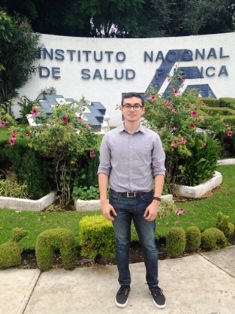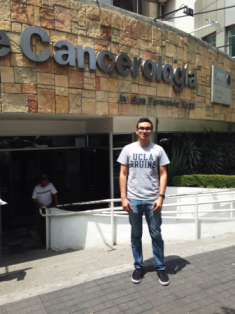Report from the field: 2015 UCLA Blum Summer Scholar Edgar Corona in Cuernavaca Morelos, México
Report from the field: 2015 UCLA Blum Summer Scholar Edgar Corona in Cuernavaca Morelos, México.
by Edgar Corona, MD Candidate-199059.jpg) A)
A)  B)
B)
It's currently raining heavily, and through the walls of the apartment that I'm renting I can hear the thudding sounds of the rain as it crashes through the trees outside onto the red cobblestone walkway that I use to get to and from the building. "Cuernavaca: La ciudad de la eterna primavera" (Cuernavaca: City of the Eternal Spring), where it rains beautifully at night, during the most convenient times, and where the sun shines brightly thought the picturesque city throughout the day. I can't begin to express how blessed I feel to have the opportunity to work, live, and learn in such a beautiful and welcoming city. I am currently working at the Epidemiology and Health Services Unit of the Mexican Institute of Social Security in Cuernavaca, Morelos, México, about 50 km south of México City. 20 days from finishing my first year of medical school at the David Geffen School of Medicine through the PRIME program, 5-year dual degree program focusing on the development of leaders in medicine that will improve health care delivery, research, and policy in underserved communities, it's a true privilege to be in Cuernavaca, interacting with health professionals who work to transform the healthcare of an entire nation through their research in public health.
Thanks to the UCLA Blum Center, I'm here this summer working on the cost-effectiveness portion of the Forwarding Research for Improved Detection and Access for Cervical Cancer Screening Project (FRIDA Study) in Tlaxcala, México. FRIDA is revolutionizing how screening for cervical cancer screening takes place. The discovery that cervical cancer is caused by high-risk strands of the Human Papilloma Virus (hrHPV), and subsequent advances in technologies to detect hrHPV infection, have radically changed approaches to screening. Conventional pap cytology-based detection programs detect abnormal changes in cervical specimens when they have developed, and these programs are limited by the sensitivity of the Pap test (59.4%) [1]. hrHPV programs have the potential of detecting lesions before they form. Along with the development of the HPV vaccine, this radical shift in approach to screening has broad implications: mainly, we can catch the development of cancerous lesion much earlier than we could ever before. What's more, we have shown that initial cervical cancer screening with hrHPV testing is more cost-effective than the conventional Pap smear [2]. In terms of health systems and health policy, this means more women can be screened and more cancers detected/prevented. While hrHPV testing has been shown to be more sensitive than the Pap (93.1% vs 59.4%), the specificity of hrHPV testing is lower (91.8% vs. 98.3%) [1]. This means that more women will test positive (for hrHPV) yet not develop cervical cancer. For women, this translates to increased anxiety and sometimes, more invasive follow-up, such as colposcopy and biopsy, The FRIDA Study is looking to stratify the women who test positive for hrHPV, thus adding steps in between testing positive for hrHPV and colposcopy. By conducting reflexive testing on samples collected during the hrHPV testing (so that women don't have to come back for another test), we may be able to get an idea about which women are at a higher risk of developing cervical cancer than others. My job is to help us decide whether, from a management and health policy perspective, the benefit is worth the additional cost.
To be honest, I never saw myself learning research skills in cost-effectiveness analyses. Yet, when I think that there are approximately 126,000 women enrolled in this innovative study, and that my contributions will be important in guiding the health management of an entire nation for a devastating disease that rips across socioeconomic strata, yet unfairly and disproportionately affects women with decreased access to screening and follow-up, I am left humbled.
[1] Salmerón, Jorge, et al. "Comparison of HPV-based assays with Papanicolaou smears for cervical cancer screening in Morelos State, México" Cancer Causes & Control 14.6 (2003): 505-512.
[2] Flores, Yvonne N., et al. "HPV testing for cervical cancer screening appears more cost-effective than Papanicolau cytology in México" Cancer Causes & Control 22.2 (2011): 261-272
 C)
C)  D)
D)  E)
E) _-_Copy-199061.jpg) F)
F)
A) With Faculty sponsor, Yvonne N. Flores PhD (center), and Gabriela Cesarman MD (right), Hematologist at the Mexican National Cancer Institute after discussing Dr. Cesarman's research in oncolytic virotheraphy
B) Edgar Corona at The Mexican National Institute of Public Health
C) On the way to Sunday mass after a rainy Saturday night
D) At the Mexican National Cancer Institute
E) Looking out at Cortez's Palace and the Central Plaza
F) Touring the Mexican National Institute of Genomic Medicine with Principal Investigator Dr. Rafael Velázquez Cruz (far left)




